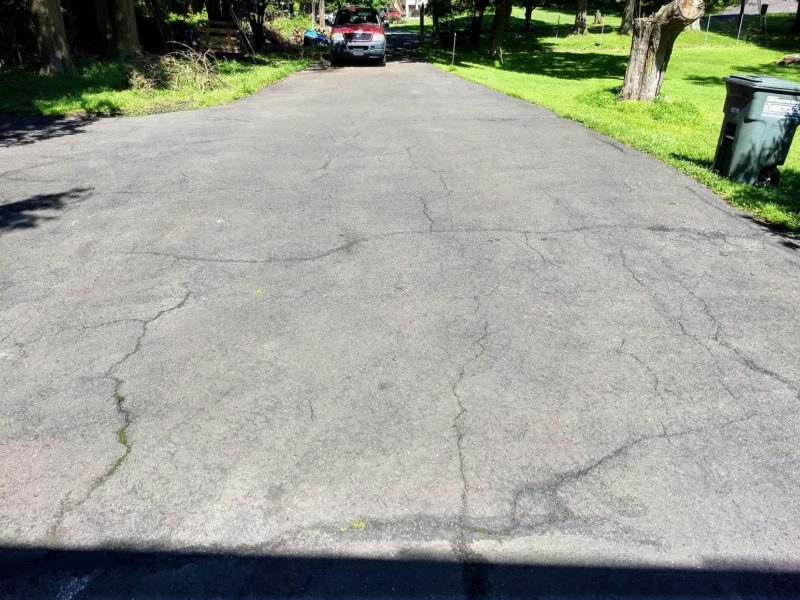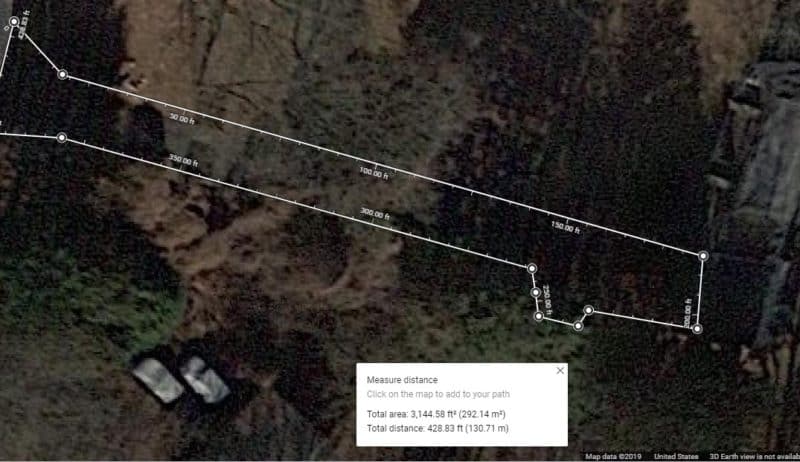Last Updated on 5 years by Christopher G Mendla
I was faced with a well worn asphalt driveway. It had not been sealed in a number of years. Was it worth trying to crack fill and seal?
Preliminaries
My home is located in southeastern PA. Asphalt driveways take a beating. I have a driveway that is about 20′ wide by about 170′ long. From what I can tell, the driveway was resurfaced at one point. A stand of Hemlocks along the property lines provides shade for a portion of the drive thus reducing some of the sun’s effect. On the other hand, ice remains longer.
The portion closest to the street gets a lot of sun. A general rule is that if you have ‘Chicken Wire’ cracking, then you should replace or resurface the driveway. Unless I hit the Lottery, that is out of the question for now.
My neighbor had their driveway resurfaced a couple of years back. They had about 2000 square feet and paid about 10 thousand dollars.
Measuring your square footage.
Let’s start with estimating square footage. Google has a nifty google maps measuring tool. If you create a closed area, it will calculate the square footage. First, find your property in Google Maps. Then turn on the satellite view. That *should* help you see your driveway. In the example below, it appears that they forgot to clean the camera lens on the satellite when they imaged my place. Start with one part and click on the various corners. You will end up with a fairly good estimate. In my case, I’m a little over 3100 square feet.
Given the price my neighbor paid and a comparison of the sizes of our driveways, I can rough guess that the cost would be about $15,000. In this case bigger is definitely NOT better. I could get quotes to be sure, but I doubt that they would be that far from this estimate.
Assess the current situation
My next step was to assess the current state of the driveway. I am not an asphalt professional but here is what I saw and the factors involved in deciding if I should proceed. :
- Overall, the driveway seemed to be in salvageable condition. (As I proceeded, I found that there was about 30 square feet where the layers had laminated. More on that later)
- There were a lot of cracks. The chicken fence cracking was in about 100-200 square feet near my gate.
- There were a number of small potholes ranging from a 6″ diameter to about 4’x4′. The end of the driveway was severely deteriorated. That ran about 15′ x 6′.
- The surface was very pitted. I knew that would really reduce the coverage for the sealer.
- TIME – Doing the job myself meant that I would have less time for other pursuits such as walks in the park with my girlfriend or writing highly profitable blog posts. On the other hand, I don’t belong to a gym. Resealing a driveway can provide some very intensive exercise.
- CURB APPEAL – I am considering downsizing at some point in the future. A pothole that looks like a road in the Ardennes during the Battle of the Bulge does not lend itself to curb appeal. If I don’t sell, I’d have a more attractive place when guest come.. I actually do have friends.
- KICK THE CAN DOWN THE ROAD A BIT – Stopping the deterioration will mean I can deal with resurfacing some time down the road.
The cracks were filled with grass in many places. That is a huge WTF. When I plant grass seed, I have to beg the grass seed gods to get it to grow. However, it will grow like crazy in the tiniest driveway crack. Oh, and one of my gutters looks like a deranged Chia Pet.
Below is the driveway closest to the garage. A word of caution. It will be a lot worse than what you originally think it will be. When you are on your knees filling cracks and potholes, you will see things you didn’t see while walking around.
Another gauge of the driveway is to look at it after a rain. That will give you an idea how bad any ruts or holes are. You can also take a broom handle and ‘tap around’ listening for hollow sounds. That would indicate delaminated layers.
Estimate material costs and time.
You can do this the right way and try to figure out the coverage. I used the Latexite Airport Grade sealer and their 2x crack filler. I also used a couple of tubs of trowel patch along with asphalt rope and tape.
In my case, the sealer claims a coverage of “300 to 400 square feet”. That estimate is for normal people who don’t let their driveway go to crap. I found that I was getting about 100 -150 square feet of coverage per pail at best. That means about 20 to 30 pails at 16.00/ pail . HINT – Home depot had a great bulk price for 3 or more pails.
So, for a 3000 square foot driveway, I expect to spend around $1500 in materials and maybe 40 hours or more in time. I’m not tracking my time.
Keep in mind that you will have to work around the weather and the curing time of the crack filler and sealers. This is NOT a weekend job. It would be more like half of your summer.
Conclusion
I decided to go ahead with the project. The cost was reasonable compared with a resurfacing.
Update August 2020
The driveway is holding up fairly well. I was planning on going back over the cracks, cleaning and doing another coat of sealer. Unfortunately a bunch of large branches came down in the woods and that seems to be occupying a lot of my time. The sealer is holding up well. I didn’t seal the areas I patched. If time permits, I might try to do at least that part of the driveway.


